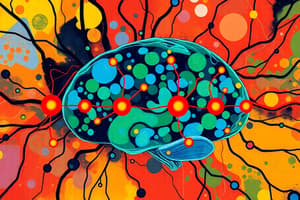Podcast
Questions and Answers
What is the primary role of serotonin in the brain?
What is the primary role of serotonin in the brain?
- Controlling pain perception
- Regulating heart rate and blood pressure
- Enhancing muscle contraction
- Affecting mood and behaviour (correct)
Which statement best describes the function of the 5-HT1A receptors?
Which statement best describes the function of the 5-HT1A receptors?
- They enhance cognitive function.
- They primarily increase serotonin release.
- They are involved in inhibiting neuronal activity. (correct)
- They are only active during sleep.
Where do serotonin cell bodies project from in the brain?
Where do serotonin cell bodies project from in the brain?
- Midline raphe nuclei (correct)
- Basal ganglia
- Hippocampus
- Hypothalamus
What is a potential consequence of altered serotonin levels?
What is a potential consequence of altered serotonin levels?
Which characteristics distinguish 5-HT2 receptors from 5-HT1A receptors?
Which characteristics distinguish 5-HT2 receptors from 5-HT1A receptors?
Which of the following neurotransmitters is primarily associated with mood disorders?
Which of the following neurotransmitters is primarily associated with mood disorders?
What is the effect of serotonin on sleep patterns?
What is the effect of serotonin on sleep patterns?
How do serotonin receptors act within the nervous system?
How do serotonin receptors act within the nervous system?
What primarily influences the production of serotonin in the brain?
What primarily influences the production of serotonin in the brain?
Which factor is least likely to support serotonin function?
Which factor is least likely to support serotonin function?
How does exercise affect tryptophan availability?
How does exercise affect tryptophan availability?
What consequence does sleep disruption have on neurotransmitters?
What consequence does sleep disruption have on neurotransmitters?
What neurotransmitter is primarily linked to emotional stability?
What neurotransmitter is primarily linked to emotional stability?
Which of the following conditions is linked to low levels of dopamine?
Which of the following conditions is linked to low levels of dopamine?
Which statement about GABA is true?
Which statement about GABA is true?
What is the primary function of adrenaline in the body?
What is the primary function of adrenaline in the body?
What is the primary role of stress in maintaining mental-emotional homeostasis?
What is the primary role of stress in maintaining mental-emotional homeostasis?
Which gene polymorphism is associated with increased vulnerability to stress-induced depression?
Which gene polymorphism is associated with increased vulnerability to stress-induced depression?
What is a characteristic of the diathesis-stress model of depression?
What is a characteristic of the diathesis-stress model of depression?
How does chronic stress differ from acute stress in terms of effects on mental health?
How does chronic stress differ from acute stress in terms of effects on mental health?
Which brain region is primarily involved in the fight or flight response?
Which brain region is primarily involved in the fight or flight response?
What is the HPA axis responsible for in the context of stress and mental health?
What is the HPA axis responsible for in the context of stress and mental health?
Which type of response is described as maladaptive to stress?
Which type of response is described as maladaptive to stress?
How do individual differences affect a person's response to stress?
How do individual differences affect a person's response to stress?
What effect does the consumption of most proteins have on the TRP/LNAA ratio?
What effect does the consumption of most proteins have on the TRP/LNAA ratio?
What is the primary benefit of alpha-lactalbumin as a protein source?
What is the primary benefit of alpha-lactalbumin as a protein source?
In which population does acute tryptophan depletion (ATD) primarily have an impact?
In which population does acute tryptophan depletion (ATD) primarily have an impact?
What effect does acute tryptophan depletion have on plasma tryptophan levels?
What effect does acute tryptophan depletion have on plasma tryptophan levels?
What is the outcome of low or excessively high brain tryptophan (Trp) levels?
What is the outcome of low or excessively high brain tryptophan (Trp) levels?
What does the inverted U-shaped curve suggest about tryptophan levels?
What does the inverted U-shaped curve suggest about tryptophan levels?
How does acute tryptophan depletion disrupt serotonin synthesis?
How does acute tryptophan depletion disrupt serotonin synthesis?
What is one potential impact of consuming whey protein with low tryptophan content?
What is one potential impact of consuming whey protein with low tryptophan content?
What effect do unphysiologically high increases in brain Trp have on mood?
What effect do unphysiologically high increases in brain Trp have on mood?
Which of the following groups is most likely to experience mood disorders due to dietary effects?
Which of the following groups is most likely to experience mood disorders due to dietary effects?
What is the relationship between stress and serotonin levels during prolonged stress?
What is the relationship between stress and serotonin levels during prolonged stress?
How does neuroticism influence responses to carbohydrate consumption?
How does neuroticism influence responses to carbohydrate consumption?
Which statement accurately reflects stress-induced changes in serotonin availability?
Which statement accurately reflects stress-induced changes in serotonin availability?
What role does serotonin play in the stress response initially?
What role does serotonin play in the stress response initially?
What factor is linked to serotonin vulnerability in specific subjects?
What factor is linked to serotonin vulnerability in specific subjects?
Which of the following is a consequence of dietary manipulation of serotonin levels?
Which of the following is a consequence of dietary manipulation of serotonin levels?
What is the primary factor that influences tryptophan uptake into the brain?
What is the primary factor that influences tryptophan uptake into the brain?
Which step in serotonin synthesis is considered the rate-limiting step?
Which step in serotonin synthesis is considered the rate-limiting step?
How do carbohydrates affect the TRP/LNAA ratio?
How do carbohydrates affect the TRP/LNAA ratio?
What role does insulin play in the context of tryptophan transport?
What role does insulin play in the context of tryptophan transport?
What is the effect of a declining TRP/LNAA ratio on serotonin levels?
What is the effect of a declining TRP/LNAA ratio on serotonin levels?
Which enzyme is responsible for the conversion of 5-HTP to serotonin?
Which enzyme is responsible for the conversion of 5-HTP to serotonin?
What effect do free fatty acids have in relation to tryptophan transport?
What effect do free fatty acids have in relation to tryptophan transport?
Which of the following large neutral amino acids does NOT compete with tryptophan for transport into the brain?
Which of the following large neutral amino acids does NOT compete with tryptophan for transport into the brain?
Flashcards
Neuromodulation
Neuromodulation
The process of altering the activity of the nervous system, either by electrical stimulation or by using chemicals.
Neurotransmitter
Neurotransmitter
A chemical messenger released by neurons that transmits signals across synapses.
Serotonin (5-HT)
Serotonin (5-HT)
A monoamine neurotransmitter involved in a range of functions like mood, sleep, appetite, and cognition.
Serotonin Receptor
Serotonin Receptor
Signup and view all the flashcards
5-HT1A Receptor
5-HT1A Receptor
Signup and view all the flashcards
5-HT2 Receptor
5-HT2 Receptor
Signup and view all the flashcards
Serotonergic System
Serotonergic System
Signup and view all the flashcards
Serotonin and Mood Disorders
Serotonin and Mood Disorders
Signup and view all the flashcards
LNAA Competition
LNAA Competition
Signup and view all the flashcards
Serotonin Synthesis Pathway
Serotonin Synthesis Pathway
Signup and view all the flashcards
Tryptophan Uptake
Tryptophan Uptake
Signup and view all the flashcards
L-tryptophan Hydroxylase
L-tryptophan Hydroxylase
Signup and view all the flashcards
Rate-limiting Step
Rate-limiting Step
Signup and view all the flashcards
TRP/LNAA Ratio
TRP/LNAA Ratio
Signup and view all the flashcards
Higher TRP/LNAA Ratio Effect
Higher TRP/LNAA Ratio Effect
Signup and view all the flashcards
Carbohydrates and Serotonin
Carbohydrates and Serotonin
Signup and view all the flashcards
Alpha-lactalbumin
Alpha-lactalbumin
Signup and view all the flashcards
Acute Tryptophan Depletion (ATD)
Acute Tryptophan Depletion (ATD)
Signup and view all the flashcards
Tryptophan-free amino acid mixture
Tryptophan-free amino acid mixture
Signup and view all the flashcards
Short-allele 5-HTT genotype
Short-allele 5-HTT genotype
Signup and view all the flashcards
Inverted U-Shaped Curve
Inverted U-Shaped Curve
Signup and view all the flashcards
Brain Serotonin Synthesis
Brain Serotonin Synthesis
Signup and view all the flashcards
Tryptophan Transport
Tryptophan Transport
Signup and view all the flashcards
Serotonin Synthesis
Serotonin Synthesis
Signup and view all the flashcards
Tryptophan Availability
Tryptophan Availability
Signup and view all the flashcards
Higher TRP/LNAA Ratio
Higher TRP/LNAA Ratio
Signup and view all the flashcards
Carbohydrates and Tryptophan
Carbohydrates and Tryptophan
Signup and view all the flashcards
The Role of Dopamine
The Role of Dopamine
Signup and view all the flashcards
The Role of Serotonin
The Role of Serotonin
Signup and view all the flashcards
The Role of GABA
The Role of GABA
Signup and view all the flashcards
Personalized Serotonin Response
Personalized Serotonin Response
Signup and view all the flashcards
Vulnerability to Dietary Mood Changes
Vulnerability to Dietary Mood Changes
Signup and view all the flashcards
Genetic Predisposition to Mood Changes
Genetic Predisposition to Mood Changes
Signup and view all the flashcards
Neuroticism and Carbohydrates
Neuroticism and Carbohydrates
Signup and view all the flashcards
Stress-Induced Serotonin Vulnerability
Stress-Induced Serotonin Vulnerability
Signup and view all the flashcards
Initial Serotonin Boost in Stress
Initial Serotonin Boost in Stress
Signup and view all the flashcards
Chronic Stress Depletion of Serotonin
Chronic Stress Depletion of Serotonin
Signup and view all the flashcards
Serotonin and Stress Response
Serotonin and Stress Response
Signup and view all the flashcards
Mental health resilience
Mental health resilience
Signup and view all the flashcards
Diathesis-stress model of depression
Diathesis-stress model of depression
Signup and view all the flashcards
5-HTTLPR (short allele)
5-HTTLPR (short allele)
Signup and view all the flashcards
HPA axis
HPA axis
Signup and view all the flashcards
Amygdala
Amygdala
Signup and view all the flashcards
Prefrontal Cortex (PFC)
Prefrontal Cortex (PFC)
Signup and view all the flashcards
Mental-emotional homeostasis imbalance
Mental-emotional homeostasis imbalance
Signup and view all the flashcards
Cognitive therapy
Cognitive therapy
Signup and view all the flashcards
Study Notes
Neuromodulation
- Neuromodulation is the process of altering nervous system activity, electrically or chemically.
- A neurotransmitter is a chemical substance released at nerve endings to transmit signals between neurons, muscles, or other structures.
Serotonin (5-HT)
- Serotonin is a monoamine neurotransmitter involved in various functions, including mood, sleep, appetite, and sexual behavior.
- Serotonin pathways originate in the raphe nuclei of the brainstem and project to various brain regions, including the brainstem, spinal cord, forebrain limbic structures, and cerebral cortex.
- Serotonin receptors are similar to docking stations, influencing neuronal activity.
- 5-HT1A receptors are inhibitory, reducing neuronal activity when serotonin binds.
- These receptors are involved in mood disorders, and their activity is regulated via a feedback mechanism controlling serotonin release.
- Other receptor types exist and are primarily either excitatory or involved in fast synaptic transmission.
Diet and Serotonin
- Serotonin is synthesized in the brain from tryptophan, an essential amino acid.
- Tryptophan is obtained from protein-rich foods.
- Tyrosine and phenylalanine are dietary precursors for catecholamines (dopamine, norepinephrine, and epinephrine).
- The blood-brain barrier limits tryptophan entry into the brain, competing for transport with other large neutral amino acids.
- Carbohydrate intake increases the tryptophan ratio, potentially increasing serotonin synthesis.
- Protein intake decreases the tryptophan ratio and can reduce serotonin synthesis.
Serotonin Synthesis Pathway
- Tryptophan is converted to 5-hydroxytryptophan (5-HTP).
- 5-HTP is then converted to serotonin (5-HT) via decarboxylation.
Impact on Mood and Stress
- Altering brain serotonin levels through diet can affect mood, stress response, and cognitive function.
- Mood disorders are associated with altered serotonin levels, but dietary effects can vary significantly depending on the individual's genetic predisposition.
Other Neuromodulation Forms
- Exercise increases tryptophan availability to the brain, potentially increasing serotonin production.
- Sleep disruption can alter neurotransmitter balance.
- Social interaction can influence neurotransmitter function.
Stress and Serotonin
- Stress can lead to reduced serotonin levels and function.
- Chronic stress can deplete tryptophan, thereby reducing serotonin production.
- The HPA axis plays a crucial role in stress response and interacts with the serotonin system.
Brain Regions and Stress
- Pre-frontal cortex (PFC) plays a role in stress response.
- Hypothalamus, pituitary, and adrenal glands influence stress response via the HPA axis.
- Hippocampus and amygdala are involved in memory and emotional responses to stress, respectively.
Other Relevant Factors
- Genes contribute to vulnerability to various mental disorders, including those related to serotonin.
- 5-HTTLPR is one genetic polymorphism that affects stress vulnerability.
- Cognitive therapy addresses negative automatic thoughts in stress response.
Studying That Suits You
Use AI to generate personalized quizzes and flashcards to suit your learning preferences.




